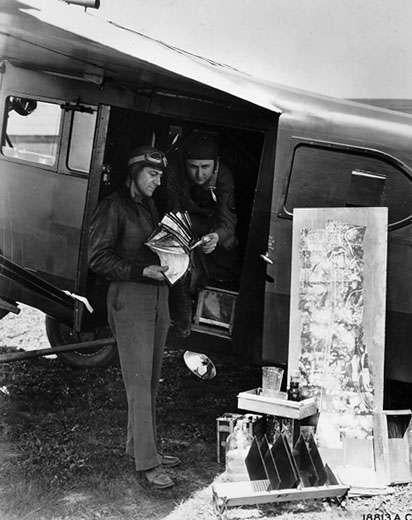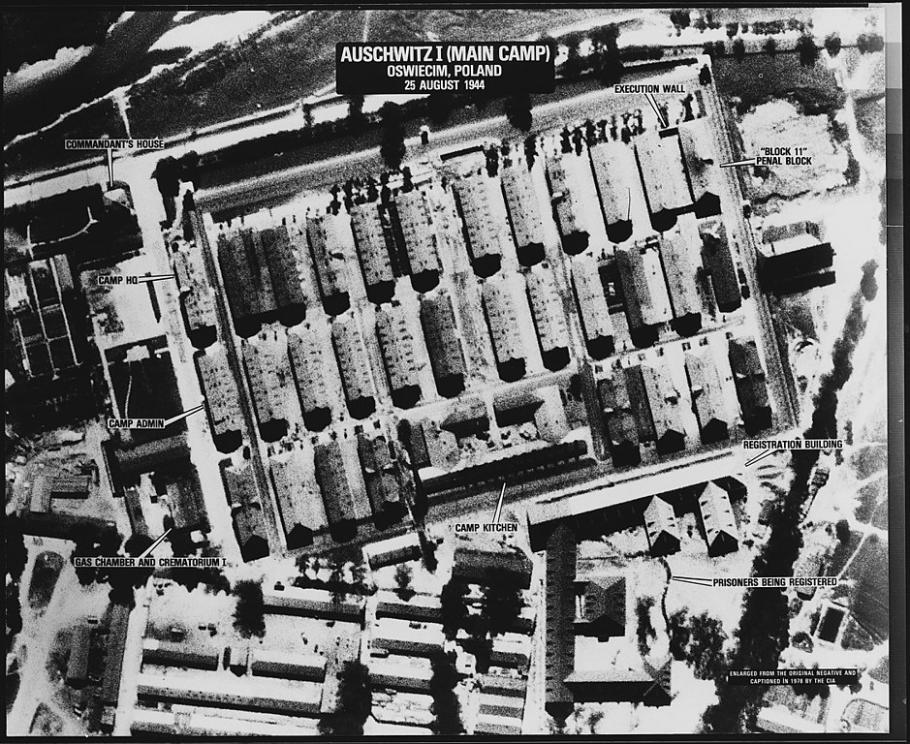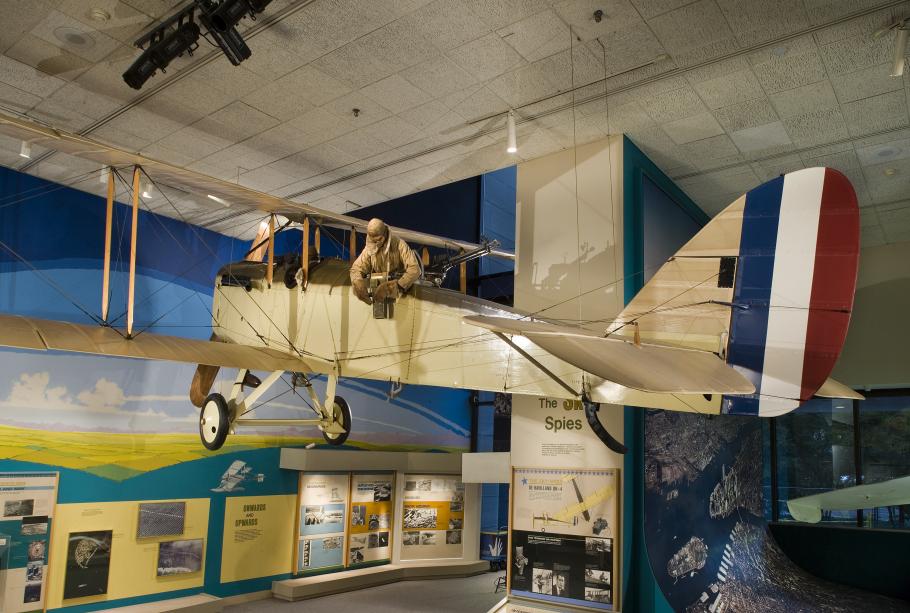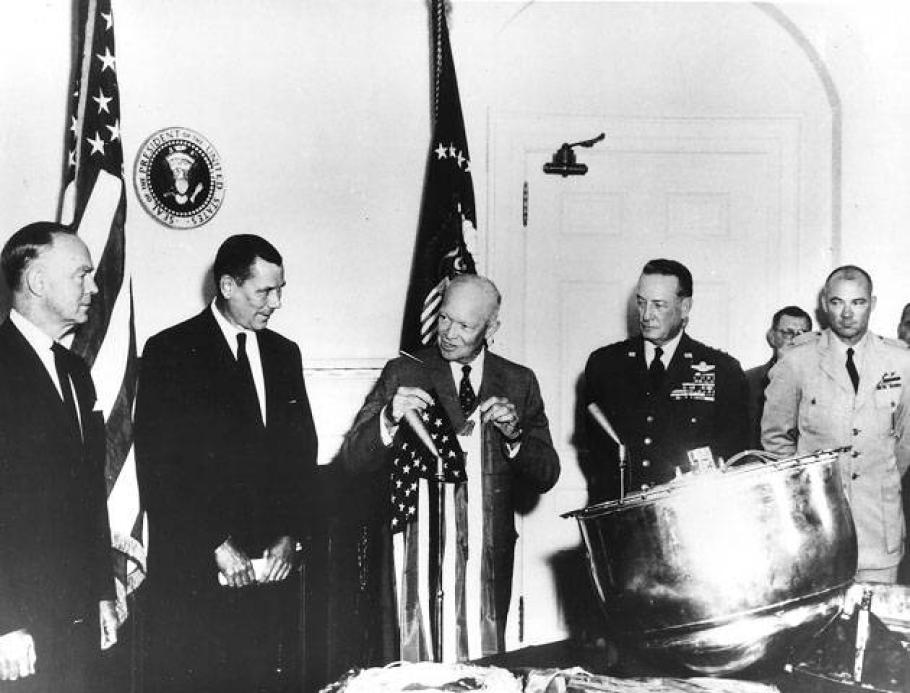Espionage, or the practice of spying, has been used by militaries to gather intelligence for centuries. During World War I, a new form of espionage took flight—literally. Photography from aircraft was introduced as a new way to spy.
Spying from the skies took a camera, a plane, and daring flight personnel. Let’s take a closer look at the evolution of each.
Cameras
Early aerial cameras were sometimes mounted rigidly on the outside of an airplane to obtain vertical views. Aircraft vibration, however, proved a serious problem. In the 1920s, Sherman Fairchild designed the K-3, a revolutionary new aerial camera that advanced the technology of aerial photography. Electrically driven (as compared to previous cameras which used a hand crank), the Fairchild K-3 camera had different variations, both of which featured a between-the-lens shutter that produced precision photography for vertical and oblique missions.
The K-3A camera had a Veeder automatic instrument data recorder that imprinted information directly onto the film. Before this addition, photographers would have to manually record information about each image as it was taken, such as the location, time, and date. The Veeder automatic instrument data recorder removed this step, making the documentation of aerial reconnaissance photography easier to keep track of and more accurate. The K-3B camera pictured below on the other hand, lacked the Veeder automatic instrument data recorder, but accepted six different focal length lenses. Fairchild later started an aerial survey and map-making company.
James Bagley of the US Army Corps of Engineers developed a 3-lens camera around 1917. The three lenses, one vertical and two oblique, provided expanded ground coverage without adding the distortion produced by the wider-angle lenses of the day. Operated manually, the camera recorded the three exposures simultaneously on one roll of film. As technology advanced, more and more lenses could be added. Fairchild developed a 5-lens camera around 1926. Actually, five separate cameras linked together, the T-3 produced one vertical and four oblique images simultaneously.
To provide quick access to reconnaissance photography, portable labs were sometimes towed into the field. These large tents had separate rooms for developing and printing. Inside the lab, which was equipped with its own generator, as many as 200 prints could be processed per hour.
As photographic technology progressed, portable labs were carried right on-board reconnaissance aircraft. In World War II, a portable dark room, seen below, was used for immediate processing of film on-board reconnaissance aircraft. Sometimes swift acquisition of photo intelligence was so important that photo interpreters went along on the reconnaissance mission to radio in instantaneous analysis of the film developed in flight.
George Goddard was one of America's foremost innovators in aerial photography. He started his training at the Officer's School in Aerial Photography, US School of Military Aeronautics at Cornell University in 1917, and later rose to such positions as Director of the Army Photographic School at Chanute Field, Illinois, Chief Photographic Officer in Charge of Aerial Photographic Research at Wright Field, Ohio, and Aerial Reconnaissance Chief of NATO. His work greatly advanced the technology in many fields of aerial photographic science including night reconnaissance photography, in-flight processing, high-altitude and long-range lenses, and the use of infrared film for distinguishing camouflage.
Goddard pioneered the development of nighttime reconnaissance photography. One night in 1925, he stunned Rochester, N.Y., by igniting an 80-pound flash powder bomb to light up the whole city. The result was the first aerial night photograph.
During World War II, aerial reconnaissance proved to be essential in understanding the capabilities of Axis technology, such as the V-2 rocket, and helped Allied forces locate key targets for bombing such as bridges and roads. Aerial reconnaissance also uncovered the horrors of German concentration camps.
After World War II, aerial reconnaissance became a key tool against the Soviet Union during the Cold War. For example, photoreconnaissance played a vital role in the Cuban Missile Crisis of 1962. Aerial photos verified both the presence and removal of Soviet missiles in Cuba.
Aircraft
The first major conflict in which photography taken from aircraft was used for military intelligence was World War I (1914-1918). The de Havilland DH-4 proved to be quite versatile during the war. In addition to bombing activities, the DH-4 was also used an observation and photoreconnaissance aircraft. Between the wars, the "Liberty Planes," as the DH-4s were called, took on civilian reconnaissance work and other jobs, including forest patrols and geologic reconnaissance. For ten years they served as the Army Air Service's standard airplane for aerial mapping and photography.
Airplanes and radio for military use grew in parallel. Even in World War I, Britain sought to jam navigation signals used by German airships. As various nations began developing radar for detecting aircraft in the 1930s, a need for aerial electronic reconnaissance emerged. During World War II, the United States developed specially outfitted units called ferrets to locate and monitor enemy radar stations. This information allowed Allied bombing raids to use decoys and electronic countermeasures – such as radio frequency jammers and chaff (metal foil strips) – to confuse Axis radars. During the Cold War, the massive Soviet bloc air defense networks posed an enormous threat to the U.S. and NATO partners. Electronic reconnaissance became even more significant. It was dangerous duty as potential opponents were often willing to risk confrontation by engaging these reconnaissance flights. Dozens of American aircrew lost their lives performing these essential missions. During the Vietnam War, the United States faced a capable Soviet-supplied air defense network and began fielding sophisticated modifications of existing aircraft. These efforts were not completely successful, and the U.S. military invested heavily in expanding its capability so that in Operation Desert Storm (Iraq, 1991) and Operation Allied Force (Serbia, 1999), the U.S. was able to quickly suppress enemy air defenses with minimal losses.
Various aircraft have been used for aerial reconnaissance—from prop planes to supersonic jets—take a look at a few examples from the Museum’s collection.
Custom Image Caption
A 3-seater observation plane used in the late 1930s and early 1940s, the O-47 was designed to provide a wide field of view for aerial observation and photography. (Smithsonian Institution)
Custom Image Caption
A reconnaissance version of the P-38, the F-5 received widespread use during World War II in Europe, North Africa, and Japan. Usually flying without back-up fighter escort, the F-5 often carried five cameras in place of weaponry. (Smithsonian Institution)
Custom Image Caption
Developed in the mid-1950s by Clarence "Kelly" Johnson and his team, the U-2 was designed for high-altitude photoreconnaissance. Equipped with a 24-meter (80-foot) wingspan to aid in achieving maximum altitude, the U-2 at first could fly over the Soviet Union unharassed by Russian jets and antiaircraft missiles which were unable to match its performance. The U-2 in our collection, seen here, is a U-2C painted in camouflage colors for a special Air Force project. (Smithsonian Institution)
Custom Image Caption
A supersonic reconnaissance aircraft, the RF-101 Voodoo flew unarmed and could carry as many as six cameras. Missions flown have included low altitude reconnaissance of the Soviet missile buildup in Cuba, and photo flights over North Vietnam. (Smithsonian Institution)
Custom Image Caption
No reconnaissance aircraft in history has operated globally in more hostile airspace or with such complete impunity than the SR-71, the world's fastest jet-propelled aircraft. The Blackbird's performance and operational achievements placed it at the pinnacle of aviation technology developments during the Cold War. It has flown high-altitude missions over such areas as Southeast Asia and the Middle East. (Smithsonian Institution)
People
Reconnaissance pilots and other flight personnel, often unarmed and alone, are the unsung heroes of many a battle and campaign. The invaluable information they gather on an opponent's position, movement, strength, and intentions, provides knowledge for informed decisions, assurance of treaty compliance, and warning of dangers to come. Because of the classified nature of their work, flyers of many nations go unheralded and unrecognized. Here are but a few Americans who have braved hostile skies in the hopes of collecting that one vital photo that makes all the difference.
Custom Image Caption
Karl Polifka
One of the most famous and daring American reconnaissance pilots was Karl Polifka, who flew missions during both World War II and the Korean conflict. Throughout his career he photographed vital targets in the South Pacific, the Mediterranean, and Korea. When in his mid-thirties and thought too old to fly dangerous missions, he would put himself down in the records as "Lieutenant Jones" and fly anyway. In 1951, he was killed on a reconnaissance sortie to Kaesong, Korea, when his plane was shot down and his parachute caught on its tail. (Department of Defense Photograph)
Custom Image Caption
Elliot Roosevelt
Elliott Roosevelt, the son of President Franklin Roosevelt, pictured here presenting a reconnaissance briefing to Dwight Eisenhower in North Africa in 1942. That year Roosevelt was made commander of a photographic unit of the 12th Air Force. While in command, he voluntarily went along on innumerable reconnaissance flights, handling such jobs as photographer, observer, navigator, and radio operator. In 1943, he took command of Allied reconnaissance operations for a large area of the Mediterranean. A Brigadier General by 1945, he received many decorations including the Distinguished Flying Cross. (Defense Visual Information Center)
Custom Image Caption
Commander William B. Ecker
Cmdr. William B. Ecker took the first low-altitude close-up shots of the missiles in Cuba. (Defense Visual Information Center)
Custom Image Caption
Major Rudolph Anderson
Maj. Rudolf Anderson, Jr., the sole casualty of the Cuban Missile Crisis, lost his life on October 27, 1962, when his U-2 aircraft was shot down during a photo reconnaissance run. He was posthumously awarded the Purple Heart, the Cheney Award, and the Air Force Cross. (Defense Visual Information Center)
Custom Image Caption
Francis Gary Powers
Francis Gary Powers was flying a U-2 reconnaissance mission over the Soviet Union when he was shot down in May 1960. He was later released in February 1962, in exchange for a Soviet agent. This U-2 incident came at a time when East-West tensions were easing, or so it seemed. The U-2 flight became one of the issues that canceled the summit conference between President Eisenhower and Premier Khrushchev, which was scheduled for May 16, 1960. The U-2 came to symbolize high-risk U.S. intelligence efforts and the fragility of peaceful coexistence during the Cold War. (Smithsonian Institution)
Custom Image Caption
General James R. Brickel
Then-Lt. Col. James R. Brickel, one of the top reconnaissance pilots of the Vietnam War, is shown here on March 10, 1967 after a photo mission over the Thai Nhuyen steel mill. During the flight, his aircraft was hit by an 85mm shell which damaged the left engine and aileron. Bickel retired with the rank of General. (General James Brickel)
The next step upward from aerial reconnaissance is orbital reconnaissance. From orbit, satellites can monitor vast areas in great detail. Photography from spy satellites is a significant legacy of the Space Race and the Cold War. Reconnaissance was one of the first priorities of spaceflight.
Development of photoreconnaissance satellites began in the mid-1950s, primarily to target the Soviet Union. They were much less provocative than aircraft overflights and photographed a far larger area. A highly classified joint Air Force-CIA project, codenamed CORONA, developed the first-generation satellites. Officials assigned the cover name of Discoverer to the program, stating that it was a scientific satellite program. From its first successful mission in August 1960 to May 1972, more than 100 successful CORONA missions acquired critical photography. Among other things, it enabled U.S. officials to learn the numbers and locations of Soviet nuclear-armed missiles and bombers.
Beginning in early 1960s, reconnaissance satellites also began collecting signals intelligence (foreign communications, foreign radar signals, and signals from foreign rockets, missiles, and spacecraft). The satellites acquired a wider range of signals than aircraft, ships, and ground stations. They either transmitted the intercepts in real-time to ground stations or recorded them and transmitted them to these facilities. The intelligence obtained from their analysis was critical in many areas, from helping to develop countermeasures to radars to assisting in the determination of the performance characteristics and missions of rockets, missiles, and spacecraft. Most of the information on signals intelligence satellites remains classified.
Two other photoreconnaissance satellite systems that performed the same missions have also been declassified – GAMBIT (1963-1984) and HEXAGON (1971-1984). All the many other systems remain completely classified. Today, military reconnaissance is carried out through a variety of ways, both in orbit and in the sky.





